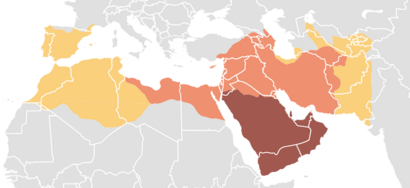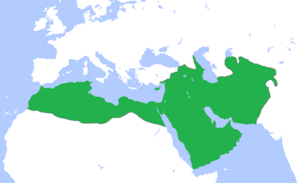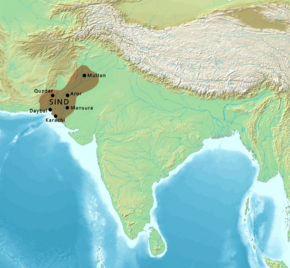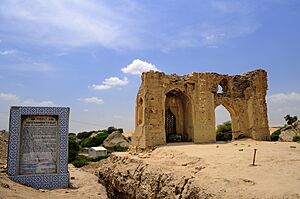Muhammad ibn al-Qasim facts for kids
Quick facts for kids
Muhammad ibn al-Qasim
|
|
|---|---|
|
محمد بن القاسم
|
|
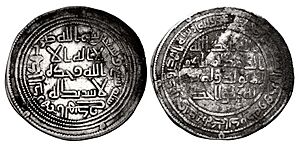
|
|
| 1st Governor of al-Sindh | |
| In office 712 – 18 July 715 |
|
| Leader | Al-Walid I |
| Preceded by | Position established |
| Succeeded by | Habib ibn al-Muhallab |
| Personal details | |
| Born | 31 December 695 Taif, Hejaz, Umayyad Caliphate (present-day Saudi Arabia) |
| Died | 18 July 715 (aged 19) Mosul, Umayyad Caliphate (present-day Iraq) |
| Spouse | Zaynab (daughter of al-Hajjaj ibn Yusuf) |
| Relations | Sulb, al-Hajjaj (brother) |
| Parents |
|
| Nickname | فاتح سندھ |
| Military service | |
| Allegiance | |
| Battles/wars | Muslim conquest of Sind (708–711) Siege of Debal (711) Battle of Aror (711) |
Muḥammad ibn al-Qāsim al-Thaqafī (Arabic: محمد بن القاسم الثقفي; born in 695 CE, died in 715 CE) was a young but important Arab military leader. He worked for the Umayyad Caliphate, which was a large Islamic empire. Muhammad ibn al-Qasim led the Muslim conquest of Sindh (a region in modern-day Pakistan).
His military actions helped create the Islamic province of Sindh. He took control of the region from the local ruler, Raja Dahir. After capturing the capital city of Aror, Muhammad ibn al-Qasim became the first Muslim leader to successfully take land in the Indian subcontinent. This event marked the start of Muslim rule in parts of South Asia.
Muhammad ibn al-Qasim came from the Banu Thaqif tribe, located near Taif in western Arabia. He became the governor of Fars (in modern Iran). From 708 to 711, he led the conquest of Sindh. He then served as its governor from 712 until his death in 715. He died in Mosul, in modern Iraq, though some say he was buried in Makran.
Contents
Early Life and Family Connections
Muhammad was born around 694 CE in the Hejaz region of western Arabia. This was either in Ta'if, his tribe's home, or in Mecca or Medina. His tribe, the Thaqif, became very important in the early Islamic empire. They held high military and government positions.
Muhammad's family gained influence because of his father's cousin, al-Hajjaj ibn Yusuf. Al-Hajjaj was a powerful commander and later became the viceroy (a ruler representing the caliph) of Iraq and the eastern parts of the Caliphate. Al-Hajjaj helped many members of the Thaqif tribe get important jobs. Muhammad's father was a deputy governor in Basra.
We don't know much about Muhammad's childhood. Historians believe he grew up in places like Ta'if, Basra, and Wasit. Basra was a major center for military and learning. He likely received his education and training under the guidance of al-Hajjaj. Al-Hajjaj thought highly of Muhammad.
Becoming Governor of Fars
Muhammad ibn al-Qasim's first big job was in the province of Fars (modern Iran). He was sent to deal with a group of rebels. After successfully completing this mission, he was made the governor of Fars. He likely took over from his uncle, Muhammad ibn Yusuf al-Thaqafi.
Muhammad ibn al-Qasim is also credited with helping to rebuild the city of Shiraz. He built a royal house and a military camp there. He was also given the task of bringing other areas under control, including regions near the Caspian Sea.
Why the Umayyads Wanted Sindh
The Umayyad Caliphate became interested in Sindh for several reasons. One major reason was the actions of a tribe called the Meds, who lived in Sindh. These Meds were known for being pirates. They attacked ships from the mouth of the Tigris River all the way to Sri Lanka.
Now, they were attacking Arab ships from their bases in Kutch, Debal, and Kathiawar. Sindh was a wild border region with many semi-nomadic tribes. Their activities disrupted trade in the western Indian Ocean. Muslim sources say that these pirate attacks on important trade routes forced the Arabs to take control of the area. They wanted to secure the seaports and sea routes, as well as the land routes.
During Hajjaj's time as governor, the Meds of Debal kidnapped Muslim women traveling from Sri Lanka to Arabia. This incident gave the Umayyad Caliphate a reason to expand their power into the Makran, Balochistan, and Sindh regions.
Another reason for the campaign was that Sindh was providing safety to people who were rebelling against the Umayyad rule.
A letter from an Arab girl who escaped from a prison in Sindh asked Hajjaj for help. When Hajjaj asked Raja Dahir to release the prisoners, Dahir refused. Because of this, Al-Hajjaj sent Muhammad ibn al-Qasim to take action against Sindh in 711 CE.
Conquering the Sindh Valley
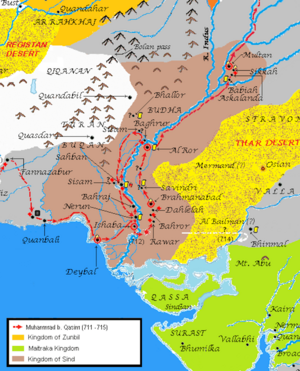
Desert areas (Registan Desert and Thar Desert) Zunbils Kingdom of Sindh (c. 632– 712 CE) Maitraka Kingdom (c.475–c.776 CE)
Al-Hajjaj planned this campaign very carefully. He gave command to Muhammad ibn al-Qasim when he was only 15–17 years old. This was because two previous commanders had failed to deal with Raja Dahir. Al-Hajjaj stayed in close contact with Muhammad ibn al-Qasim, receiving regular reports.
Muhammad ibn al-Qasim's army started with 6,000 cavalry from Syria and other soldiers from Iraq. As they reached Sindh, more soldiers joined them. Reinforcements and five large catapults were also sent by sea to Debal. The army grew even larger with local people like the Jats and Meds joining after hearing of the Arab successes.
The first town they attacked was Debal. Muhammad ibn al-Qasim followed orders to take control of Debal. From Debal, the army moved north-east, taking towns like Nerun and Sadusan without much fighting. A portion of the war gains, including captured people, was sent to al-Hajjaj and the Caliph.
The conquest of these towns was quite easy. However, Raja Dahir's main army was waiting across the Indus River. Muhammad went back to Nerun to get more supplies and reinforcements. He then made deals with local river people to help his army cross the Indus.
At Aror, Muhammad ibn al-Qasim's forces met Dahir's army in a major battle. Dahir was killed in this battle, and his forces were defeated. Muhammad ibn al-Qasim then took control of Sindh. After the battle, fighting soldiers were executed. However, artisans, merchants, and farmers were generally spared.
Soon, other important cities like Brahmanabad, Alor, and Multan were captured. Many cities were taken after a siege, often with the help of local merchants who made agreements with the Arabs. After battles, fighting men were executed, and their families were sometimes enslaved. However, the general population was encouraged to continue their work, and taxes were set.
The conquest of Sindh was a significant achievement for the Umayyad Caliphate. However, further attempts to expand into India were stopped by powerful Hindu kingdoms. Arab attempts to invade deeper into India were defeated by kings like Bappa Rawal, Nagabhata I, and Vikramaditya II. After these failures, the Arab leaders eventually gave up on conquering more parts of India.
Military and Political Strategy
Al-Hajjaj had a clear military strategy for Muhammad ibn al-Qasim. He ordered him to fight those who resisted and to take their families as hostages. But for those who did not fight, he was to offer them peace and protection if they agreed to pay taxes.
The Arabs wanted to conquer Sindh with as few losses as possible. They also wanted to protect the economy of the region. Towns were given two choices: surrender peacefully or be attacked by force. Surrendering peacefully usually meant better treatment for the people. Many towns were captured through agreements with local leaders.
If a town resisted strongly and caused many Arab casualties, Muhammad ibn al-Qasim's response was harsh. For example, there were many deaths at Aror, Brahmanabad, and Multan. However, in areas that surrendered peacefully, there were few casualties. Muhammad ibn al-Qasim preferred peaceful surrender. He was even told off by Al-Hajjaj for being too lenient sometimes. The common people were often pardoned and encouraged to continue their lives.
Reasons for Success
Muhammad ibn al-Qasim's success had several reasons:
- Some historians believe Raja Dahir was not popular with the local Buddhist majority. They saw his family as having taken power unfairly. This might have led to some Buddhists and other groups supporting Muhammad.
- The Arab army had better military equipment, like siege engines (large machines for attacking forts) and the Mongol bow.
- Their troops were well-disciplined and had strong leaders.
- The idea of Jihad (holy struggle) boosted their morale.
- Many believed in the prophecy of Muslim success.
- Local groups like the Samanis were persuaded to surrender.
- Some of Dahir's own chiefs and nobles switched sides.
Governing Sindh
After conquering Sindh, Muhammad ibn al-Qasim had to set up a stable government. He wanted to make sure the local people accepted Muslim rule. He promised not to interfere with their religious practices if they paid their taxes. In return, the government would protect non-Muslims from attacks.
He introduced Islamic law, called Sharia, but Hindus were allowed to govern their own villages. They could also settle disputes using their own laws. Traditional local leaders, like village headmen and chieftains, were kept in their positions. A Muslim officer with cavalry was placed in each town to manage it.
Taxes and tributes were collected everywhere. Non-Muslims did not have to serve in the military. Instead, they paid a special tax called jizya. This tax was higher for richer people and lower for the poor. Also, a small part of the government's income was given to the Brahmins.
Including Local Leaders in Government
Muhammad ibn al-Qasim included Hindus and Buddhists in his government. They served as trusted advisors and governors. A Hindu named Kaksa became the second most important person in his administration. Raja Dahir's prime minister and other chieftains were also given roles in the new government.
Religion and Tolerance
Historians note that Muslim rule was generally tolerant and focused on the economy. Collecting the jizya tax was a big economic reason for not forcing people to convert to Islam. Hindus and Buddhists were considered "Dhimmis," meaning protected people. They paid jizya instead of Zakat, which Muslims paid.
A small number of people who converted to Islam were given special treatment. They were excused from jizya and paid Zakat instead. Muhammad ibn al-Qasim set Zakat at 10% of farm produce. Some temples, like the Sun Temple of Multan, were not destroyed if jizya was paid.
While some people converted to Islam, the spread of Islam in Sindh was slow. It took centuries for large numbers of people to convert. Most of the population remained Hindu and continued to pay the jizya tax.
Death of Muhammad ibn al-Qasim
Al-Hajjaj, Muhammad's patron, died in 714 CE. A year later, Caliph al-Walid I also died. His brother, Sulayman, became the new Caliph. Sulayman was not friendly to the generals who had been close to al-Hajjaj. He removed them from their positions.
Sulayman recalled Muhammad ibn al-Qasim from Sindh. He also appointed a new governor for the region, who immediately put Muhammad in chains.
Muhammad ibn al-Qasim died on July 18, 715 CE, in Mosul, which is in modern-day Iraq. Some sources say his body was later moved to Makran in Balochistan, Pakistan.
There are different stories about how Muhammad ibn al-Qasim died:
- One account says he was killed because of a conflict with the new governor of Iraq. Sulayman was angry with Muhammad because Muhammad had followed al-Hajjaj's orders to cancel Sulayman's right to become caliph in the lands he conquered. Muhammad was arrested and tortured to death by officials who had personal grudges against al-Hajjaj.
- Another story, from the Chach Nama, tells a dramatic tale. It says that Raja Dahir's daughters, Surya Devi and Parimal Devi, were captured during the campaign. They were sent as gifts to the Caliph. The story claims they tricked the Caliph into believing Muhammad had disrespected them. As a result, the Caliph ordered Muhammad to be wrapped in oxen hides, which led to his death from suffocation on the way to Syria. This story says the sisters did this to get revenge for their father's death. When the Caliph found out he had been tricked, he ordered the sisters to be buried alive.
What Happened Next
After Muhammad ibn al-Qasim left, the next Arab governor died soon after arriving. Raja Dahir's son briefly recaptured some territory. He was later pardoned and joined the government after converting to Islam. However, he soon changed his mind and broke away when the Umayyads faced problems. Later, another Arab general recaptured the territory.
During the Abbasid period (around 870 CE), local leaders in Sindh became independent from the caliphs. By the 10th century, the region was split into two separate states. These states were later taken over by another group called the Ismailis. The Arab conquest remained limited to what is now southern Pakistan for three centuries. Powerful Hindu kingdoms to the north and east stopped further advances until the arrival of Mahmud of Ghazni.
Legacy and Importance
Muhammad ibn al-Qasim's time as ruler was short. However, his conquest brought Sindh into the Muslim world. After conquering Sindh, he adopted a policy that allowed Hindus, Buddhists, and Jains to have religious freedom. They were considered "dhimmis" (protected people) as long as they paid the jizya tax. This approach was very important for how Muslim rulers governed India for centuries afterward.
Trade along the coast and the presence of Muslim communities in Sindh led to cultural exchange. It also helped Sufi missionaries spread Muslim influence.
Debal remained an important port for a long time. It strengthened trade links with the Persian Gulf and the Middle East. Sindh became a key point for trade across the Indian Ocean and for land routes.
Muhammad Ali Jinnah, the founder of Pakistan, believed that the idea of Pakistan began when the first Muslim arrived in Sindh. Muhammad ibn al-Qasim is often seen as the first "Pakistani" in the Pakistan Studies curriculum. Pakistan observes "Yom-e Bab ul-Islam" (Day of the Gateway of Islam) in his honor.
Several places in Pakistan are named after him, including Port Qasim (Pakistan's second largest port), Bagh Ibn Qasim (a large park in Karachi), and Ibn-e-Qasim Bagh Stadium in Multan. The Pakistan Naval Station Qasim (PNS Qasim) and Bin Qasim Town in Karachi are also named after him.
See also
- Jat people in Islamic history
- Muslim conquests on the Indian subcontinent
- Caliphate campaigns in India
- Abdullah Shah Ghazi
- Shaikh Habib Al-Raee
Images for kids



